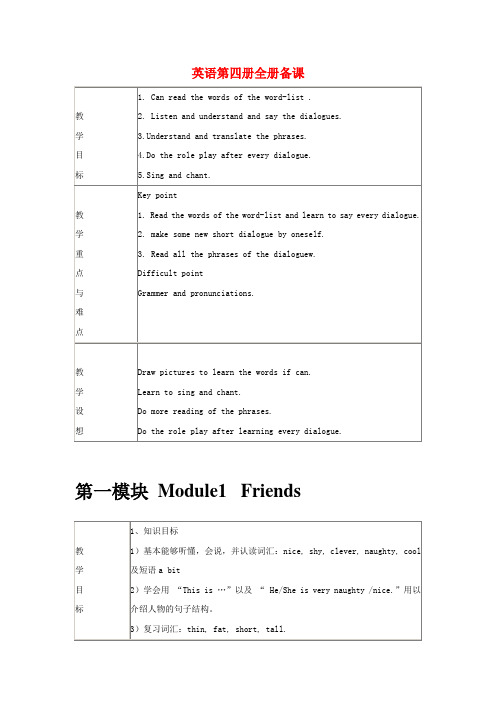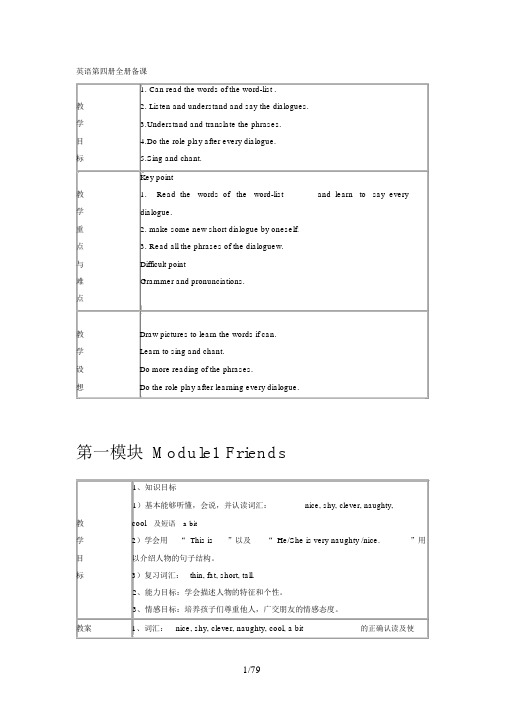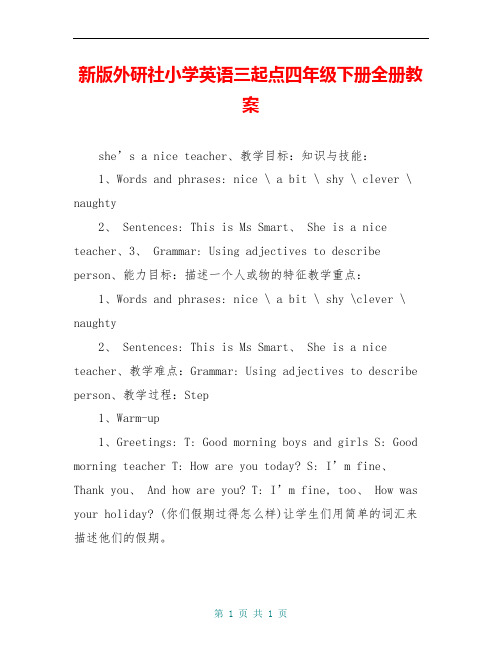小学四年级下册新标准外研版英语三年级起点第四册全册教案(已排版无需改动)
外研版英语三年级起点四年级下册全册教案精品

英语第四册全册备课第一模块Module1 FriendsShe’s a nice teacher.a bit shya nice teachera clever pupila very naughty birdHe’s cool. big brother little sister coolcuteThis is my friend , Mary.. She is very nice.She is tall and thin.第二模块Module2 LondonLondon is the capital of England.a book about LondonBuckingham Palacevery big and very beautifulthe Queen’s houseThis is the River Thames.The River Thames long and wide many boats on the river Big Ben very old very tallHyde Park very beautifulTower Brige very famous very beautifulLondonthe River Thames Big BenHyde park Tower Bridge Buckingham Palace第三模块Module 3 PicnicWill you take your kite?We are going to have a picnic. Will you take your ball?Yes, I will. No, I won’t.On Monday I’ll go swimming.Tuesday Wednesday Thursday Friday Saturday Sundayplay with my friends go to the park do my homework visit my grandma help my mother read my booksgo swimmingplay with my friendsdo my homeworkhelp my mothervisit my grandma第四模块Module 4 RobotsRobot will do everything.Will they do the housework? Yes, they will.No, they won’t.Will it be windy in Beijing?be hot sunny windy coldrain snowrain snow第五模块Module 5 Size板书设计:Module 5 Unit 1:Amy’s taller than Lingling.talltaller板书设计:Unit 2:Beijing is bigger than Tianjing.big biggerhigh higher old older long longer板书设计:Sizethan 比较级I’m taller than xiaoxiao.第六模块Module 6 Music板书设计:Module 6Unit 1 This girl is good. good better板书设计:Unit 2:Lingling is better than Daming.the erhu the zither the guitar play the drums板书设计:MusicPop musicChinese music第七模块Module 7 Countries。
外研社(三年级起点)小学英语四年级下册全册教案教学设计(表格版)

播放录音。
T:Doyouknowothersceneries(景点)inLondon?
DoyouknowtheThames(泰晤士河)/theBritishMuseum(大英博物
馆)/theLondonEye(伦敦眼)/WestminsterAbbey(威斯敏斯特大教堂)
教师展示这些景点的图片,让学生借助图片认读
introduceyourfamilymember.
ⅢPractice
1.Listentothetape,trytofindPanpan’sfamily
member.
S;motherbigbrotherlittlesisterfatherfriend.
学习little,然后领读所有家庭成员
2.Listenagain,thenanswerquestion
example:ThisisDongdong.He’sveryclever.)
S:,,,,,
让更多的学生做这个练习,旨在复习前一课知识,为新课做
准备,在学生之间做练习时,教师可以顺便去问一下,Are
younaughty\clever\shy\?让学生了解这种一般疑问句。
ⅡPresentation
1.Sowecanuse“Thisis…,He’s\She’s…”to
设计意图:分别从听说读写四方面来训练和提升学生
的英语素养,摆脱传统以写为主忽视学生口语练习的弊
端。让学生能够把课堂中学习的对话用于日常生活中。
(三)Practice
1.游戏:Whoishe\she?(他\她是谁?)在课件中
呈现几张图片(刘星—naughty;小雪---clever;小雨
---cute;躲在妈妈背后的豆豆---shy;笑脸---nice)让
外研版英语三年级起点四年级下册全册教案(全英文表格式)

英语第四册全册备课1.Can read the words of the word-list .教 2.Listen and understand and say the dialogues.学 3.Understand and translate the phrases.目 4.Do the role play after every dialogue.标 5.Sing and chant.Key point教 1.Read the words of the word-list and learn to say every学dialogue.重 2. make some new short dialogue by oneself.点 3.Read all the phrases of the dialoguew.与Difficult point难Grammer and pronunciations.点教Draw pictures to learn the words if can.学Learn to sing and chant.设Do more reading of the phrases.想Do the role play after learning every dialogue.第一模块 Module1 Friends1、知识目标1)基本能够听懂,会说,并认读词汇:nice, shy, clever, naughty,教cool及短语 a bit学2)学会用“ This is”以及“ He/She is very naughty /nice.”用目以介绍人物的句子结构。
标3)复习词汇:thin, fat, short, tall.2、能力目标:学会描述人物的特征和个性。
3、情感目标:培养孩子们尊重他人,广交朋友的情感态度。
教案1、词汇:nice, shy, clever, naughty, cool, a bit的正确认读及使重点用。
小学英语外研版(三起)四年级下册四册教案.docx

小学英语外研版(三起)四年级下册Module 1 Friends元分析本模分两元Unit 1 She's a nice teacher.And Unit 2 He's cool.整个模介了怎描述人物的性格特征?要求学生能用的句子好友的性格、外形行描述。
同复了上学期学的一些fat thin small big tall short ,从而引出 naughty shy niceclever 等几个新。
在本模中,出了两个表示程度的副 a bit /very,分表示‘有一点儿’和‘非常’可以修后面的形容,鼓励学生在造句使用适当的副。
unit 1 She’ s a nice teacher.一教学目1 知目1)基本能听懂会、会nice shy clever naughty2)学会用“This is⋯”以及He/She is very nice .的言构3)复short tall thin fata bit2 技能目能介并描述人物的性格特点3 情感目培养孩子尊重他人的情感度二教学重点正确灵活运用句子 This is ⋯ He /She is⋯三教学流程Step 1Warm-up1greetings2Play a game .出反tall thin fat short 等Step 2 presentationT : (手拿相片) look ,this is my friend ⋯ .she’s a teacher .she’s very tall . This is my little sister . she’s a bit shy .Do you remember our friend Panpan . Panpan would like to introduce them to us .let Step 3’ s got some new friends .He ’s see who they are .1 listen to the tape and find out new words .2 将生 naughty clever nice shy 写在黑板的右(要求学生听音模仿,并行拼)3演一演,猜一猜。
新版外研社小学英语三起点四年级下册全册教案

新版外研社小学英语三起点四年级下册全册教案she’s a nice teacher、教学目标:知识与技能:1、Words and phrases: nice \ a bit \ shy \ clever \ naughty2、 Sentences: This is Ms Smart、 She is a nice teacher、3、 Grammar: Using adjectives to describe person、能力目标:描述一个人或物的特征教学重点:1、Words and phrases: nice \ a bit \ shy \clever \ naughty2、 Sentences: This is Ms Smart、 She is a nice teacher、教学难点:Grammar: Using adjectives to describe person、教学过程:Step1、Warm-up1、Greetings: T: Good morning boys and girls S: Good morning teacher T: How are you today? S: I’m fine、Thank you、And how are you? T: I’m fine, too、 How was your holiday? (你们假期过得怎么样)让学生们用简单的词汇来描述他们的假期。
2、 Review T: In my holiday, I have made manyfriends(交了许多朋友)。
D o you want to know my friends? Ok, Let’s look at them together、 (见附带的可课件)Step2、 New teaching1、Listening (听力教学)T; Panpan also has made many friends in holiday、Let’s see who they are、1) Listen to the tape and answer the matching question、 (见附带课件中的连一连)2)Listen the ape again and fill in the blanks (见附带课件中的填一填)2、New words (单词教学)T: Let’s look at the new words for today、 (见附带课件中的写一写)Learn the new words by reading and writing (使用单词卡片)在讲解 shy, nice, naughty 时,向学生展示图片3、New structure (句型教学)T: 叫一个男生到讲台上上,然后用 This is+ 人名;He’s very\a bit+ 形容词介绍他再叫一个女生到前面,用同样的句型介绍。
(新版)外研社(三年级起点)小学英语四年级下册全册教案

S:nice cool(学习cool) cute(学习新单词) clever naughty
3.listen and repeat,then read in groups.
4.Ask some students to read the text.
教学后记:
备课人
使用人
学科
英语
课题
London isa big city.
课时
3
教学目标
1、words: London, capital, about, beautiful, Buckingham Place, Queen.
2、Sentences: London isa big cityIt’s very big.
呈现课件,师生拍手齐说本册书第二模块的歌谣。既起到热身作用又复习曾经学过的形容词,激活旧知。
Step 2. Leading in (导入并感悟)
看课件里的图片,猜并描述。
挡住图片的一部分猜是什么,再描述它的特征。
如, It’s a snake. This snake is long.
最后呈现的图片为太空,新授生词“space”。
Step二、新授
在愉快的氛围中,师告诉学生:“Amy和Lingling是同班同学。一天,Amy带来了一本关于自己家乡—伦敦的书。Lingling看见这本书后非常好奇,于是就请Amy向她介绍伦敦的情况。现在我们就来跟Amy学一学怎样描述城市和景物。今天学习过后,请大家也来介绍一下自己熟悉的城市、地区或景物。
教学过程
个性化设计
教学过程
Step 1.Warming up.(热身)1. Greeting.2. Say a chant.
小学四年级下册新标准外研版英语三年级起点第四册全册教案(已排版无需改动)
新标准英语三年级起点第四册教案Module 1 FriendsUnit 1 she’s a nice teacher.Teaching objectives:1. Words and phrases: nice \ a bit \ shy \ clever \ naughty2. Sentences: This is Ms Smart.She is a nice teacher.3. Grammar: Using adjectives to describe person.Teaching properties: cards \ pictures \ photo \ Tape-recorder \ CAITeaching procedures:A: Song: There are twelve months in the year.B: Free talk: Talk about your holiday.C: New concepts:Step one:One :利用CAI课件, 出示本单元主人公的头像,介绍主人公,以此引出本单元新单词:nice \ a bit \ shy \ clever \ naughty 出示卡片,学习新单词。
Two: Learn the new lesson.Listen to the tape .Try to read the text. Translate the sentences.Listen to the tape again, read follow the tape.Read the text, boys and girls.Step Two: Talk about the pictures.Close your books, show the pictures (parrot,Xiaoyong,Maomao,Ms Smart)Example :( 1) This is Parrot.Parrot is a very naughty bird.(2) This is Xiaoyong .He‘s a clever pupil.Step Three: Using adjectives to describe person.利用实物投影展示学生带来的照片。
小学四年级下册新标准外研版英语三年级起点第四册全册教案
新标准英语三年级起点第四册全册教案Module 1 FriendsUnit 1 she’s a nice teacher.Teaching objectives:1. Words and phrases: nice \ a bit \ shy \ clever \ naughty2. Sentences: This is Ms Smart.She is a nice teacher.3. Grammar: Using adjectives to describe person.Teaching properties: cards \ pictures \ photo \ Tape-recorder \ CAITeaching procedures:A: Song: There are twelve months in the year.B: Free talk: Talk about your holiday.C: New concepts:Step one:One :利用CAI课件, 出示本单元主人公的头像,介绍主人公,以此引出本单元新单词:nice \ a bit \ shy \ clever \ naughty 出示卡片,学习新单词。
Two: Learn the new lesson.Listen to the tape .Try to read the text. Translate the sentences.Listen to the tape again, read follow the tape.Read the text, boys and girls.Step Two: Talk about the pictures.Close your books, show the pictures (parrot,Xiaoyong,Maomao,Ms Smart)Example :( 1) This is Parrot.Parrot is a very naughty bird.(2) This is Xiaoyong .He’s a clever pupil.Step Three: Using adjectives to describe person.利用实物投影展示学生带来的照片。
外研版英语(三起点)四年级下册全册教案(教学设计)
外研版英语四年级下册全册教案学校:____________教师:____________2020年3月Module 1Unit 1 She’s a nice teacher.知识目标:a) 能听、说、认读下列单词:nice、clever、shy、naughtyb) 能听懂、会说下列句型:He’s / She’s a bit/ very …c) 初步了解转折的表达方式:She’s very nice. But she’s a bit sh y. 能力目标: 能简单描述周围人的性格特征、个性特点。
情感目标:能用英语向他人介绍某人的性格特征、个性特点,培养学生认真观察、善于观察的好习惯,进一步通过活动使学生热爱英语,培养学生团结友爱、互帮互助的良好习惯。
教学重点:描述性格的形容词汇与句型的学习和运用。
教学难点:描述周围人的性格特征、个性特点。
教具:学图片、单词卡片、单词陀螺、课件。
每人一张人物个性特点调查表。
教学过程Ⅰ热身复习. (3’)①问候:T——S②听唱歌曲《The more we get together.》(学生一边拍手一边唱)Ⅱ呈现新授(20’)通过歌曲引出本课的话题T:This is a song about friends. Today we will talk about our friends. let’ssee who can describe his\her friends best. And let’s see which group is the best in this class.T: Now the first, let’s recognize Panpan’s fr iends. 课件出示Panpan’s的四位朋友Do you want to know how does Pan-pan appraise his friends?播放录音,让学生们回答下列问题(1)What are their friends names?(2)What is each person’s temperament?让学生尽可能用英语回答问题.(1)课件出示毛毛的图片T: Who is she? (Maomao)What’s she like? (nice \a bit shy)S: She’s nice.T: Yes. And she’s nice. But a bit shy(课件出示单词、教读、拼读单词)nice. a bit shy(板贴图片、板书单词)S: Practise in groups.(因为以前曾经接触过,所以由学生来当小老师进行检查)T: Who is nice in our class?(学生通过观察,根据实际情况回答问题,对单词和句子有更深刻的理解)(2)教师用同的方法出示小勇的图片新授单词clever(3)教师用同的方法出示鹦鹉的图片新授单词naughtyⅢ课文学习(5’)1、教师播放录音,学生边听边用手指出相应的图片。
小学四年级下册新标准外研版英语三年级起点第四册全册教案
新标准英语三年级起点第四册教案Module 1 riendsUnit 1 she’s nice techer.Teching objectives:1. Words nd phrses: nice \ bit \ shy \ clever \ nughty2. Sentences: This is Ms Smrt.She is nice techer.3. Grmmr: Using djectives to describe person.Teching properties: crds \ pictures \ photo \ Tpe-recorder \ CITeching procedures:: Song: There re twelve months in the yer.B: ree tlk: Tlk bout your holidy.C: New concepts:Step one:One :利用CI课件, 出示本单元主人公的头像,介绍主人公,以此引出本单元新单词:nice \ bit \ shy \ clever \ nughty 出示卡片,学习新单词。
Two: Lern the new lesson.Listen to the tpe .Try to red the text. Trnslte the sentences.Listen to the tpe gin, red ollow the tpe.Red the text, boys nd girls.Step Two: Tlk bout the pictures.Close your books, show the pictures (prrot,Xioyong,Momo,Ms Smrt)Exmple :( 1) This is Prrot.Prrot is very nughty bird.(2) This is Xioyong .He’s clever pupil.Step Three: Using djectives to describe person.利用实物投影展示学生带来的照片。
- 1、下载文档前请自行甄别文档内容的完整性,平台不提供额外的编辑、内容补充、找答案等附加服务。
- 2、"仅部分预览"的文档,不可在线预览部分如存在完整性等问题,可反馈申请退款(可完整预览的文档不适用该条件!)。
- 3、如文档侵犯您的权益,请联系客服反馈,我们会尽快为您处理(人工客服工作时间:9:00-18:30)。
新标准英语三年级起点第四册教案Module 1 FriendsUnit 1 she’s a nice teacher.Teaching objectives:1. Words and phrases: nice \ a bit \ shy \ clever \ naughty2. Sentences: This is Ms Smart.She is a nice teacher.3. Grammar: Using adjectives to describe person.Teaching properties: cards \ pictures \ photo \ Tape-recorder \ CAITeaching procedures:A: Song: There are twelve months in the year.B: Free talk: Talk about your holiday.C: New concepts:Step one:One :利用CAI课件, 出示本单元主人公的头像,介绍主人公,以此引出本单元新单词:nice \ a bit \ shy \ clever \ naughty 出示卡片,学习新单词。
Two: Learn the new lesson.Listen to the tape .Try to read the text. Translate the sentences.Listen to the tape again, read follow the tape.Read the text, boys and girls.Step Two: Talk about the pictures.Close your books, show the pictures (parrot,Xiaoyong,Maomao,Ms Smart)Example :( 1) This is Parrot.Parrot is a very naughty bird.(2) This is Xiaoyong .He‘s a clever pupil.Step Three: Using adjectives to describe person.利用实物投影展示学生带来的照片。
(Describe the person using the adjectives Homework: Introduce your classmates to your family.Example: This is Xiaoyong.He‘s a clever pupi l.Game: 接龙游戏Example: A: I‘m XiaoLan. I‘m a bit shy.B: XiaoLan is a bit shy. I‘m ZhangYong. I‘m very nayghty.C: ZhangYong is very naughty. I‘m Jim, I‘m a nice boy.…Designs: Module One: FriendsModule 1 FriendsUnit 2 He’s cool.Teaching objectives:1. Words and phrases: cool \ little \ cute.2. Sentences: This is this is my big brother, He‘s cool.Teaching propertie s: cards \ Tape-recorder \ CAITeaching procedures:A: Song: Row Row Row your boat.B: Free talk: Using adjectives to describe the poem.C: New concepts:Step one: Warmer:Using the adjectives to describe your classmates.Example: ① This is Xiaoyong.He is a clever pupil.② This is Yuanjiaqi.She‘s very clever, but she‘s a bit shy.Step Two: Listen and point.(1) Point out the different meanings of the word ―cool‖.In this unit, ―cool‖ means fashionable, and it is most commonly used to mean ―quite cold‖. The word ―cool‖ has other meanings as well, but they are ones that the students are unlikely to come across in the future.(2) Listen to the tape and underline the new words. Write down these adjectives on the board, and then learn these new words.Listen to the tape again. Read the text.Close your book. Use CAI shows the pictures of text. Choose some students to describe the pictures.Step Three: Listen and say, then say the poem and do the acti ons.Play the spoken version of the poem. And have the students. Repeat each line. Play the tape and have the students.Step four:Tell the students that they are going to work in groups of three or four.Do the AB unit 2.Homework:Choose some words to write about your friend.Example: This is my friend×××. She is a clever pupil. At school, she‘s a bit shy, but at home, she is very naughty girl.Game:Explain that they are going to play a game where they have to whisper some information to their classmate. That classmate has to whisper the information to the next person. The last person. That person has to say that he \she heard. Then, the other students listen carefully to find out if the message has changed at all.Designs:Unit 2 He‘s cool.mother --- nicebig brother --- coollittle sister --- cutefather --- cleverfriend --- naughtyModule 2 LondonUnit 1 London is the capital of England.Teaching objectives:1、Words and phrases: capital, about, beautiful,be from2、Sentences:I‘m from London.London is the capital of England.It‘s very big and very beautiful.3、Grammar: the present tenseTeaching properties: cards, pictures, tape—recorderTeaching procedures:A: Chant: This is a little girl, and she has a little curl. And when she is good, she is very, very good. And when she is bad, she is very, very bad!B:Talk Free:T: Hello! Boys and girls. I‘m a teacher. Are you a teacher?S1: No, I‘m not.S2: No, I‘m a pupil.T: Are you naughty?S3: No, I‘m not.T: Are you clever?S4: Yes, I am.……(反复操练,以此复习上节所学到的描述人物性格的单词:naughty, shy, clever, nice, cool.)C:New concepts:Step 一、导入利用卡片教授“capital”,反复领读,读熟之后带入句子“London is the capital of England.”中。
Then translate it into Chinese. 找生用英语说出“北京是中国的首都。
”鼓励学生踊跃参加抢答赛“说首都”,学生可以用中文说。
Step 二、新授在愉快的氛围中,师告诉学生:“Amy 和Lingling 是同班同学。
一天,Amy 带来了一本关于自己家乡—伦敦的书。
Lingling 看见这本书后非常好奇,于是就请Amy 向她介绍伦敦的情况。
现在我们就来跟Amy 学一学怎样描述城市和景物。
今天学习过后,请大家也来介绍一下自己熟悉的城市、地区或景物。
请学生听录音,听一听Amy 和Lingling 之间的对话。
师:“Where is London?”生在地图上指出伦敦的位置。
再放一遍录音,让学生在自己的书上勾出描述城市的形容词(nice, big, beautiful, small)。
